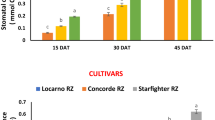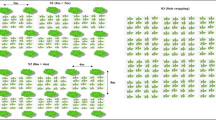Abstract
Due to recurring agricultural water shortages, many farmers are looking for crops such as pomegranate that have both some degree of drought resistance and a higher economic value. To manage limited water effectively, it is necessary to know how pomegranate trees respond to varying levels of applied water and the type of irrigation system used. This study was conducted in experimental orchards located at the University of California Kearney Agricultural Research and Extension (UC KARE) Center and the USDA-ARS San Joaquin Valley Agricultural Sciences Center in Parlier, California. The impact of surface drip (DI) and subsurface drip irrigation (SDI) at the UC KARE orchard and irrigation levels (35, 50, 75, 100% of crop water use) at the USDA-ARS orchard on tree canopy size [fractional canopy ground cover (f c), normalized difference vegetation index (NDVI), normalized difference infrared index (NDII)], canopy-to-air temperature difference, and fruit yield was determined during the 2012–2014 growing seasons. There was no difference in tree canopy size between the DI and SDI systems at the UC KARE site; but trees under SDI produced larger fruit in 2013 and higher yield whilst saving about 10% of water application. The difference in water application highlights an advantage of SDI over DI systems to conserve water without creating negative impacts on tree size or yield. At the USDA-ARS site, the 35 and 50% irrigation treatments significantly reduced tree canopy size in 2013 and 2014, compared to the 75 and 100% irrigation treatments. In 2014, trees irrigated with 75% of crop water use produced more yield than trees irrigated at 35% of crop water use. Furthermore, NDVI and NDII were correlated to f c. The relationships between NDVI to f c and f c to pomegranate crop coefficient were established. The derived crop coefficient from ground-based remotely sensed data may potentially be used as a tool by farmers and water managers to estimate pomegranate tree water use on a field or regional scale using aerial or satellite imagery.





Similar content being viewed by others
Notes
Mention of trade names or commercial products in this publication is solely for the purpose of providing specific information and does not imply recommendation or endorsement by the U.S. Department of Agriculture.
References
Allen RG, Pereira LS, Raes D, Smith M (1998) Crop evapotranspiration-Guidelines for computing crop water requirements-FAO Irrigation and drainage paper 56. FAO, Rome 300:6541
Ayars JE, Mead RM, Soppe RW, Clark DA, Schoneman RA (1996) Weighing lysimeters for shallow ground water management studies. In: Camp CR, Sadler EJ, Yoder RE (eds) Proceedings of the international conference on evapotranspiration and irrigation scheduling. St. Joseph, ASAE, Mich, pp 825–837
Ayars JE, Phene CJ, Hutmacher RB, Davis KR, Schoneman RA, Vail SS, Mead RM (1999) Subsurface drip irrigation of row crops: a review of 15 years of research at the Water Management Research Laboratory. Agric Water Manag 42:1–27
Ballester C, Castel J, Jiménez-Bello MA, Castel JR, Intrigliolo DS (2013) Thermographic measurement of canopy temperature is a useful tool for predicting water deficit effects on fruit weight in citrus trees. Agric Water Manag 122:1–6
Bausch WC (1995) Remote sensing of crop coefficients for improving the irrigation scheduling of corn. Agric Water Manag 27(1):55–68
Behnia A (1999) Comparison of different irrigation methods for pomegranate orchards in Iran. Irrigation under conditions of water scarcity. 17th International Congress Irrigation and Drainage, 13–17 Sept. Granada, Spain, 1C, pp 207–217
Bryla DR, Trout TJ, Ayars JE (2003) Growth and production of young peach trees irrigated by furrow, microjet, surface drip, or subsurface drip systems. HortScience 38(6):1112–1116
Chopade SQ, Gorantiwar SD, Pampattiwar PS, Supe VS (2001) Response of pomegranate to drip, bubbler and surface irrigation methods. Adv Hortic For 8:53–59
Fereres E, Soriano MA (2007) Deficit irrigation for reducing agricultural water use. J Exp Bot 58(2):147–159
Gao BC (1996) A normalized difference water index for remote sensing of vegetation liquid Water from space. Remote Sensing Envirn 58:257–266
Glenn DM, Worthington JW, Welker WV, McFarland MJ (1989) Estimation of peach tree water use using infrared thermometry. J Am Soc Hortic Sci 114(5):737–741
Goldhamer DA, Viveros M, Salinas M (2006) Regulated deficit irrigation in almonds: effects of variations in applied water and stress timing on yield and yield components. Irrig Sci 24(2):101–114
Grattan S, Bowers W, Dong A, Snyder R, Carroll J, George W (1998) New crop coefficients estimate water use of vegetables, row crops. Calif Agric 52(1):16–21
Han M, Zhang H, DeJonge KC, Comas LH, Trout TJ (2016) Estimating maize water stress by standard deviation of canopy temperature in thermal imagery. Agric Water Manag 177:400–409
Hardisky MA, Klemas V, Smart RM (1983) The influences of soil salinity, growth form, and leaf moisture on the spectral reflectance of Spartina alterniflora canopies. Photogramm Eng Remote Sens 49:77–83
Hepaksoy S, Kukul YS, Engin H, Erogul D, Aksehirli M (2009) Leaf water potential of pomegranate (Punica granatum l.) under different irrigation levels. Acta Hortic 818
Holland D, Hatib K, Bar-Yàakov I (2009) Pomegrante: botany, horticulture and breeding. Hortic Rev 35:127–191
Intrigliolo DS, Nicolas E, Bonet L, Ferrer P, Alarcón JJ, Bartual J (2011) Water relations of field grown Pomegranate trees (Punica granatum) under different drip irrigation regimes. Agric Water Manag 98(4):691–696
Intrigliolo DS, Bonet L, Nortes PA, Puerto H, Nicolas E, Bartual J (2013) Pomegranate trees performance under sustained and regulated deficit irrigation. Irrig Sci 31:959–970
Johnson LF, Trout TJ (2012) Satellite NDVI assisted monitoring of vegetable crop evapotranspiration in California’s San Joaquin Valley. Remote Sens 4(2):439–455
Khattab MM, Shaban AE, El-Shrief AH, El-Deen Mohamed AS (2011) Growth and Productivity of Pomegranate Trees under Different Irrigation Levels I: vegetative Growth and Fruiting. J Hortic Sci Ornament Plants 3:194–198
Kimes D, Markham B, Tucker C, McMurtrey J III (1981) Temporal relationships between spectral response and agronomic variables of a corn canopy. Remote Sens Environ 11:401–411
Lansky EP, Newman RA (2007) Punica granatum (pomegranate) and its potential for prevention and treatment of inflammation and cancer. J Ethnopharmacol 109:177–206
Marino G, Pallozzi E, Cocozza C, Tognetti R, Giovannelli A, Cantini C, Centritto M (2014) Assessing gas exchange, sap flow and water relations using tree canopy spectral reflectance indices in irrigated and rainfed Olea europaea L. Environ Exp Bot 99:43–52
Mellisho CD, Egea I, Galindo A, Rodríguez P, Rodríguez JB, Conejero W, Romojaro F, Torrecillas A (2012) Pomegranate (Punica granatum L.) fruit response to different deficit irrigation conditions. Agric Water Manag 114:30–36
Michel DS, Melanie ERN, Gerdi W, Jennifer JD, Mailine HC, Ruth M, Caren J, Raisin RN, Dean O (2005) Effect of pomegranate juice consumption on mycocardialperfusion in patient with coronary heart disease. Am J Cardiol 96:810–814
Phene CJ, McCormick RL, Davis KR, Pierro J, Meek DW (1989) A lysimeter feedback system for precise evapotranspiration measurement and irrigation control. Trans Am Soc Agric Eng 32:477–484
Phene CJ, Hoffman GJ, Howell TA, Clark DA, Mead RM, Johnson RS, Williams LE (1991) Automated lysimeter for irrigation and drainage control. Lysimeters for Evapotranspiraton and Environmental Measurements. ASCE, New York
Phene CJ, Hutmacher RB, Ayars JE, Davis KR, Mead RM, Schoneman RA (1992) Maximizing water use efficiency with subsurface drip irrigation. Presentation, ASAE Paper No. 92-2090, p 29. Charlotte, NC, June 21–24
Prasad RN, Bankar GJ, Vashishtha BB (2003) Effect of drip irrigation on growth, yield and quality of pomegranate in arid region. Indian J Hortic 60:140–142
Schneider AD, Ayars JE, Phene CJ (1996) Combining monolithic and repacked soil tanks for lysimeter from high water table sites. Appl Eng Agric 12(6):649–654
Serrano L, González-Flor C, Gorchs G (2010) Assessing vineyard water status using the reflectance based Water Index. Agr Ecosyst Environ 139(4):490–499
Shailendra A, Narendra A (2005) The effect of trickle irrigation on growth, yield and quality of pomegranate (Punica granatum) cv. Ganesh in Chhattisgarh region. Mysore J Agric Sci 39(2):175–181
Sulochanamma BN, Yellamanda Reddy T, Subbi Reddy G (2005) Effect of basin and drip irrigation on growth, yield and water use efficiency in pomegranate cv. Ganesh. Acta Hortic 696:277–279
Trout TJ, Gartung J (2006) Use of crop canopy size to estimate crop coefficient for vegetable crops. In: Proceedings of 2006 World Environmental and Water Resources Congress, Omaha, NE, May 2006
Trout TJ, Johnson LF (2007) Estimating crop water use from remotely sensed NDVI, crop models, and reference ET. In: Proceedings of the USCID Fourth International Conference on Irrigation and Drainage. Sacramento, CA, October 3–6, pp 275–285
Trout TJ, Johnson LF, Gartung J (2008) Remote sensing of canopy cover in horticultural crops. HortScience 43(2):333–337
Tucker CJ (1980) Remote sensing of leaf water content in the near infrared. Remote Sens Environ 1:23–32
Wang D, Phene C, Phene R, Ayars J, Tirado-Corbala R, Makus D (2015) Water and nitrogen management of young and maturing pomegranate trees. In: Yuan Z, Wilkins E, Wang D (eds) The 3rd International Symposium on Pomegranate and Minor Mediterranean Climate Fruits, 20–24 September 2013. Tai’an, China, pp 395–401
Wanjura DF, Upchurch DR, Mahan JR (1995) Control of irrigation scheduling using temperature-time thresholds. Trans ASAE 38(2):403–409
Zhang H, Wang D (2013) Management of postharvest deficit irrigation of peach trees using infrared canopy temperature. Vadose Zone Journal. doi:10.2136/vzj2012.0093
Zhang H, Anderson RG, Wang D (2015) Satellite-based crop coefficient and regional water use estimates for Hawaiian sugarcane. Field Crops Research. 180:143–154
Zhang H, Wang D, Gartung JL (2017) Influence of irrigation scheduling using thermometry on peach tree water status and yield under different irrigation systems. Agronomy 7:12. doi:10.3390/agronomy7010012
Acknowledgements
The project was partially supported with initial grants from the California Department of Food and Agriculture’s Fertilizer Research and Education Program and the California State University Systems’ Agricultural Research Initiatives Program. The authors are grateful to the generous support from Wonderful Orchards LLC (formerly the Paramount Farming Company) for donating the pomegranate trees and specifically to Erik Wilkins for providing technical guidance on orchard management. In addition, we thank Jim Gartung, Stella Zambrzuski, Don Tucker, and Matthew Gonzales for data collection; and Becky Phene and Rick Schoneman for providing UC KARE orchard-related information.
Author information
Authors and Affiliations
Corresponding author
Additional information
Communicated by D. Intrigliolo.
Rights and permissions
About this article
Cite this article
Zhang, H., Wang, D., Ayars, J.E. et al. Biophysical response of young pomegranate trees to surface and sub-surface drip irrigation and deficit irrigation. Irrig Sci 35, 425–435 (2017). https://doi.org/10.1007/s00271-017-0551-y
Received:
Accepted:
Published:
Issue Date:
DOI: https://doi.org/10.1007/s00271-017-0551-y




